If your workplace energy is not quite right and bad vibes abound, the chakra system might be the perfect guide for bringing it back into harmony. Dr. Charlie Grantham investigates.

Are the chakras in your workplace balanced? Why should you even care? As a workplace designer, one of your main goals is to bring the built environment into harmony with the people who occupy it so that it effectively supports their work. Chakras are just another conceptual design tool to create that harmony through balancing people’s different energies.
Did you know that there is a Hindu god of construction? His name is Vastu Shastra. Again, this is some of the wisdom of the ancients that we have lost. My aim in this article is to bring some of that wisdom back into modern consciousness.
How the energy flows in physical space influence energy flows in the body
“Our environments, our spaces, our homes affect every aspect of our lives. They can add stress to our way of life — or, when designed consciously, they can improve our well-being and deepen our connection to the world around us.” Joshua Smith
Energy flows in physical space influence energy flows in the body. Imagine the difference between a closed, dark room and a forest with a stream. I should say right here that these “energies” are not easily sensed because they don’t normally correspond to things which can be seen, heard, touched, or smelled. However, there are corollaries to the chakras that everyone can recognize, sort of like symbols that represent the energy. For example, the color green stands for the heart chakra, and a “low beta” (12 –30 Hz) sound stands for the throat chakra. Trained and experienced practitioners develop a great sensitivity to them and can be used to help correct system imbalances.
Workplaces function as human containers for a great part of our lives. If not designed properly, our physical comfort, mood, and even our state of mind can be affected.
There is very credible medical research that demonstrates a dynamic connection between physical surroundings, emotional responses and, ultimately, our well-being. And we all recognize that design can set a mood in people. Mood is simply an emotion, which the theory of chakras holds expresses the essence of energy centers in the body. Try a little thought experiment. Think of the moods created in your home. Dining room? Kitchen? Bedroom? What are they? They are different, aren’t they? The same is true in the workplace.
That all makes sense. But wait: what’s a chakra?
Chakras are energy centers located in specific physical points in the human body along the spine. These energy waves operate at different frequencies and are tied to various bodily functions such as breathing, circulation, and sensing.
Most of us are aware of the design discipline of Feng shui. Feng shui focuses more on the spatial orientation of buildings to energy flows. I am suggesting here that the same general approach can be taken to link human bodies to localized environments using the idea of chakras as a map.

I believe there are parallels between human physiology and different areas (parts) of the workplace. Workplaces function as human containers for a great part of our lives. If not designed properly, our physical comfort, mood, and even our state of mind can be affected.
Humans interact with workplaces not only in a physical sense, but also in terms of “energy”. We often talk about physical, emotional, and spiritual energies. The study of the chakra system just takes it one step further. Let’s look at how chakras, body location, and the corollary workspaces are related:
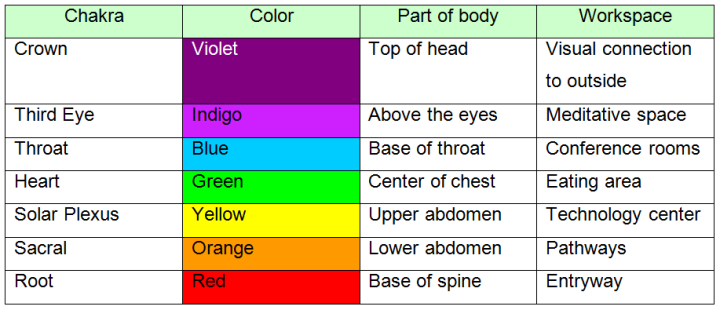
Now let’s break it down a bit, and see what the chakras look like when applied to workspaces:
The root chakra
The root chakra is the one which grounds us in physical reality, and it can be expressed as the entryway to the workplace. It is the physical thing that connects the outside to the inside. A workspace designed with the root chakra in mind would be one where people feel safe and are not threatened. Conversely, imagine a place where you need a key to get in or out. There, the chakra would be blocked and you would lose a sense of “groundedness” to the outside world. When this chakra is overactive, you have an ego-based, greedy workplace. When it is blocked, users have a fearful and frustrating workplace.
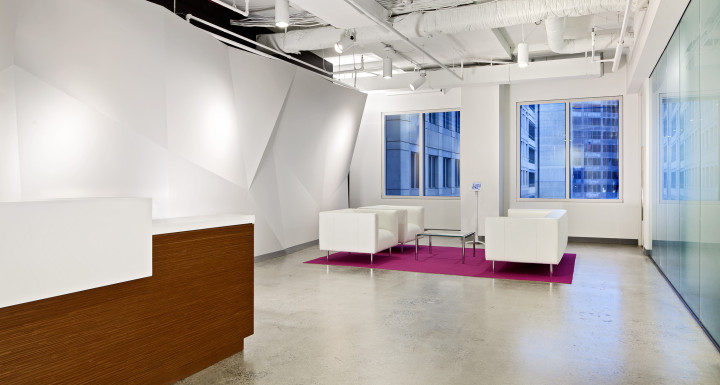
The sacral chakra
The sacral chakra has to do with the circulatory system. It is the emotional energy center and expressed as the pathways around and inside of the workplace. There is a heightened sense of awareness of other people and a collaborative atmosphere that is totally transparent to everyone. In a workplace where this energy is flowing freely, the pathways need to be visible to everyone. Overactivity is a needy, clinging place with closed cliques. A blocked one is low on interaction; it’s a “shy” workplace where people can hide.
For example, using software that shows the plan/circulation for every floor in a bigger office can contribute to a healthy workplace sacral chakra, especially if the software allows you to see how to get somewhere in the office, or to someone in particular, or to reserve a desk or other work area.
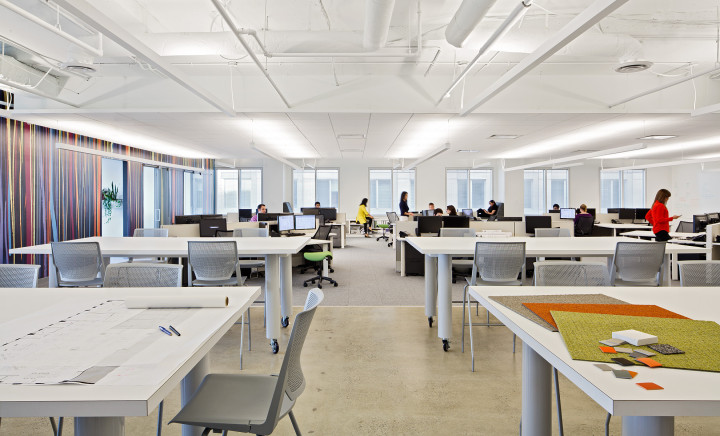
The solar plexus
The solar plexus has to do with the body’s nervous system and finds an analog in the workplace technical systems. Examples include telephones, computers, and now wireless connections (which I might add, like the chakras, we can’t see, either!). Too much energy here leads plays itself out through people being judgmental and stubborn, even though they probably don’t realize what is going on. This might manifest as an over-controlling network administrator. Conversely, too little energy becomes an apathetic, low self-esteem place, or a place made up of systems that don’t connect people.
When it is working right there is a free flow of information among people, no bottlenecks and everybody can get what they need quickly without cumbersome procedures. The watchword would be “free flowing” like a river without dams or rocks in the stream.
The solar plexus is also an expression of our ego and self-identity. We want it to be strong and balanced, not too little or too much. It’s here we find purpose which is the power of focused energy.
The heart chakra
The heart chakra is the social center of humans. We see this as the eating areas, cafeterias, or lunchrooms. With too much energy you see people who feel entitlement to power and are jealous to others, as in separate executive dining areas. With too little, uncertainty and fear of rejection means employees will eat at their desks.
Here’s another shot of the studio space at FOX Architects, which shows how it serves as the heart and soul of the enterprise, the center of activity:
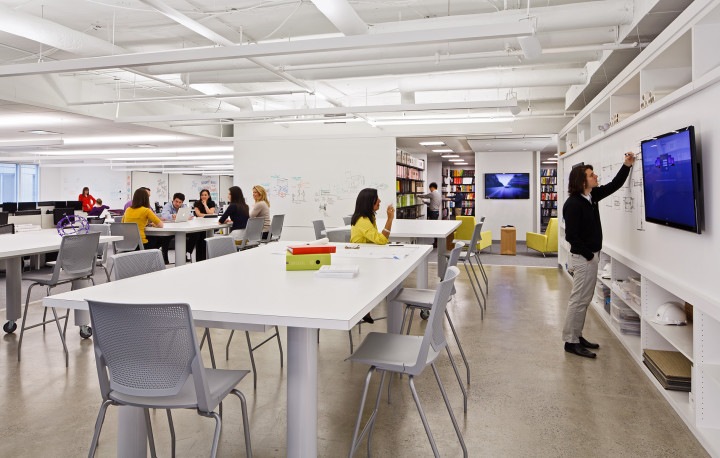
The throat chakra
The throat is the expressive area of the body where language is sent out. Where do people meet to exchange ideas in groups? Conference rooms, usually. A lot of energy here results in loud talking, over-talking, others and being critical. A deficit of energy shows up as an inability for self-expression and repressed cooperation. The throat chakra is where all the energy moving up from the lower chakras meets all the energy coming from the higher, more cerebral chakras and is given “voice”. For example, in today’s world these spaces are often called “ideation labs”. What they really are places where expression is given to thoughts.
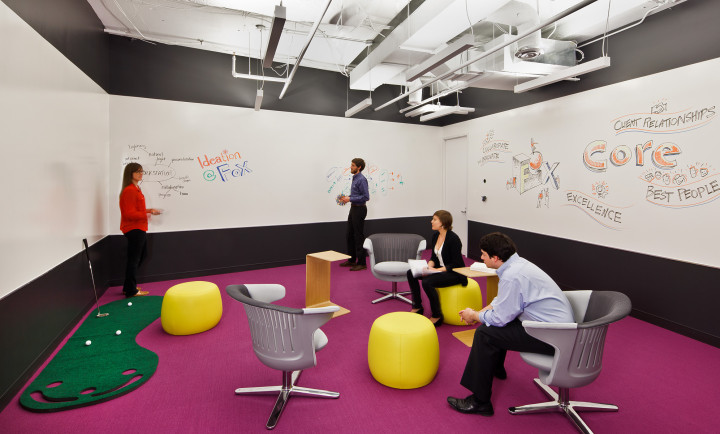
The third eye
The brow or third eye is our body-sensing organ; it is the seat of archetypes in our mind. This is where mindfulness happens. A meditative, quiet place would be a third eye workplace area. And it is usually the most neglected. This can result in a “spacy”, fantasy world-type place to work when overactive. On the other hand, the flipside would be a workplace without purpose or a context beyond day-to-day actions.
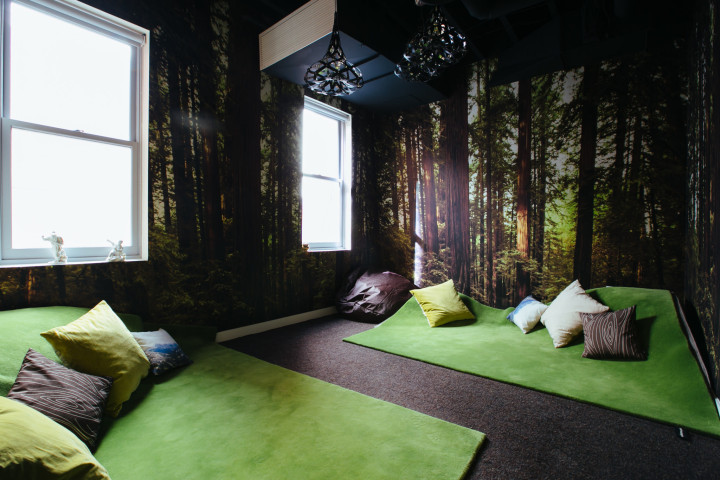
The crown chakra
The final chakra is the crown of the head. This is the mystical connection point. Consciousness resides here. The circle is now complete. We enter a workplace through a door or portal and leave it by connecting to the greater world outside of us. This is the place where we see messages about connecting the workplace to a sense of higher good. This is the place where the company broadcasts “who it is” and “why it exists”. When leaders crave attention, and you see bi-polar activity, it’s too open. Obsessive thinking, confusion, and indecision mark too little crown chakra energy.
The crown chakra is the “top floor”, so to speak, which looks out upon a larger world and shows people how their work fits into that context. I often think of the top of the Empire State building as a great example.
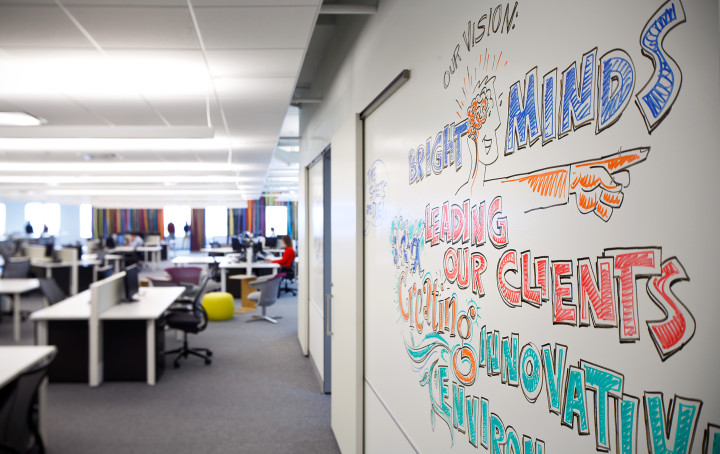
How to use the chakra system as a guide to promote more balance in the workplace
The central design principle within the chakra system is balance. That means not too much and not too little. When your workplace is out of balance, these are the work issues that may crop up:
- Root imbalance: Not connected to the reality of the customers
- Sacral imbalance: Emotion rules the day, either too much or not enough
- Solar plexus imbalance: Low self-esteem or poor branding
- Heart imbalance: No bonding among work group
- Throat imbalance: Dysfunctional communication
- Third eye imbalance: Intuition isn’t working, can’t see the forest for the trees or the larger context
- Crown imbalance: Lack of spirituality, lack of recognition of a higher good that is served by the company, its industry, and society in general.
The most obvious signs of imbalance are when not all chakras are represented in the workplace, or if there are no clear boundaries between the energy centers. For example, a mediation space connected to a lunchroom would cause problems.
These imbalances are the connection point with organizational development in the workgroup. Chakras are the physical location where we find the connections between the more ethereal and the mundane of everyday life. This is where the boundary between space (in the physical sense) and place (in the psychological sense) occurs. Perhaps Esther Sternberg put it best in her book, Healing Spaces: The Science of Place and Well-being, writing that “our sense of place is created through what we see and feel and smell and hear. Emotions both good and bad become attached to a place.”
Our sense of place is created through what we see and feel and smell and hear. Emotions both good and bad become attached to a place.
It is important to recognize that design can only go so far in balancing human systems. Physical design is a necessary but not sufficient condition for healthy organizations. Get the organizational folks involved in the design process and roll out, hopefully ones that share a Zen perspective.
If you want to bring these chakra energy centers into balance, either in your workplace, or one you are helping create, reach out to a professional. Someone who has a recognized certification in his or her field and has experience across many modalities of alternative wellness practices.
Five ways to start incorporating the chakras in your design process
Here are my top five ideas to get you started:
- Use them all: Make sure every chakra space is present.
- Signify with colors: People respond emotionally to colors. Make sure your color palette corresponds to chakra colors.
- Use gemstones for decoration: They act like tuning forks for different energy frequencies of the chakras.
- Label the purpose of the area: Give the area’s purpose as much visibility as you can.
- Give people a map: Post at entryway and other key points. Don’t assume people will figure it out for themselves.
One final note. Before you dismiss this rather unconventional design method, give it a try. Do a chakra map of your workplace. Is anything out of balance? What do you think you can do to restore that balance in energies?



I love it when people come together and share opinions, great blog, keep it up.
Keep the faith, my Internet friend, You are a first-class writer and deserve to be heard.